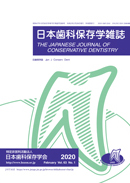Volume 63, Issue 5
Displaying 1-15 of 15 articles from this issue
- |<
- <
- 1
- >
- >|
Review
-
2020 Volume 63 Issue 5 Pages 351-355
Published: 2020
Released on J-STAGE: October 31, 2020
Download PDF (3141K)
Original Articles
-
2020 Volume 63 Issue 5 Pages 356-367
Published: 2020
Released on J-STAGE: October 31, 2020
Download PDF (13543K) -
2020 Volume 63 Issue 5 Pages 368-376
Published: 2020
Released on J-STAGE: October 31, 2020
Download PDF (1211K) -
2020 Volume 63 Issue 5 Pages 377-384
Published: 2020
Released on J-STAGE: October 31, 2020
Download PDF (1540K) -
2020 Volume 63 Issue 5 Pages 385-395
Published: 2020
Released on J-STAGE: October 31, 2020
Download PDF (639K) -
2020 Volume 63 Issue 5 Pages 396-404
Published: 2020
Released on J-STAGE: October 31, 2020
Download PDF (1136K) -
2020 Volume 63 Issue 5 Pages 405-413
Published: 2020
Released on J-STAGE: October 31, 2020
Download PDF (395K) -
2020 Volume 63 Issue 5 Pages 414-424
Published: 2020
Released on J-STAGE: October 31, 2020
Download PDF (3390K) -
2020 Volume 63 Issue 5 Pages 425-431
Published: 2020
Released on J-STAGE: October 31, 2020
Download PDF (1200K)
Case Reports
-
2020 Volume 63 Issue 5 Pages 432-437
Published: 2020
Released on J-STAGE: October 31, 2020
Download PDF (1456K) -
2020 Volume 63 Issue 5 Pages 438-444
Published: 2020
Released on J-STAGE: October 31, 2020
Download PDF (2327K) -
2020 Volume 63 Issue 5 Pages 445-450
Published: 2020
Released on J-STAGE: October 31, 2020
Download PDF (1480K) -
2020 Volume 63 Issue 5 Pages 451-460
Published: 2020
Released on J-STAGE: October 31, 2020
Download PDF (2836K) -
2020 Volume 63 Issue 5 Pages 461-466
Published: 2020
Released on J-STAGE: October 31, 2020
Download PDF (1409K) -
2020 Volume 63 Issue 5 Pages 467-473
Published: 2020
Released on J-STAGE: October 31, 2020
Download PDF (2277K)
- |<
- <
- 1
- >
- >|
